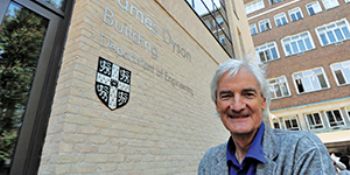
Sir James Dyson opened some of the world’s most advanced engineering facilities at the University of Cambridge (
www.cam.ac.uk) earlier this month.
The Dyson Centre for Engineering Design has been funded by an £8 million donation from the James Dyson Foundation; this is the largest gift ever received by the university’s engineering department.
Sir James (pictured), the inventor of the famous Dyson vacuum cleaner, said that the facilities will give students and academics the space and means to prototype, invest in and collaborate on cutting-edge research. It provides space for more than 1,200 engineers to carry out their project work.
A separate new four-storey building, the James Dyson Building for Engineering, houses post-graduate researchers and supports research in areas such as advanced materials, ‘smart’ infrastructure, electric vehicles and efficient internal combustion systems.
Sir James said: “The building itself is as smart as the minds it houses: fibre-optic sensors in the foundation piles, concrete columns and floor sections offer live data about temperatures and strain — providing a picture of how the building is behaving. The result is a building that’s more of a living creature than a passive block of material.”
In a press briefing held at the new centre, Sir James said: “Developing the intellectual property that will help Britain succeed in the global technology race depends on applying our brightest minds to ambitious and exciting research projects. I am hopeful that this new space for Britain’s best engineers at the University of Cambridge will catalyse great technological breakthroughs that transform how we live.”
Professor Dame Ann Dowling, president of the Royal Academy of Engineering, said: “Academic rigour must meet with practical invention. The Dyson Engineering Design Centre and the James Dyson Building for Engineering bridge the gap, encouraging engineers to apply their minds to creatively experiment and try new things.”
Meanwhile, Dyson (
www.dyson.co.uk) will open the first phase of its research, design and development campus in Malmesbury, Wiltshire, later this year, as part of a £250 million UK expansion and a wider £1.5 billion investment in technology.